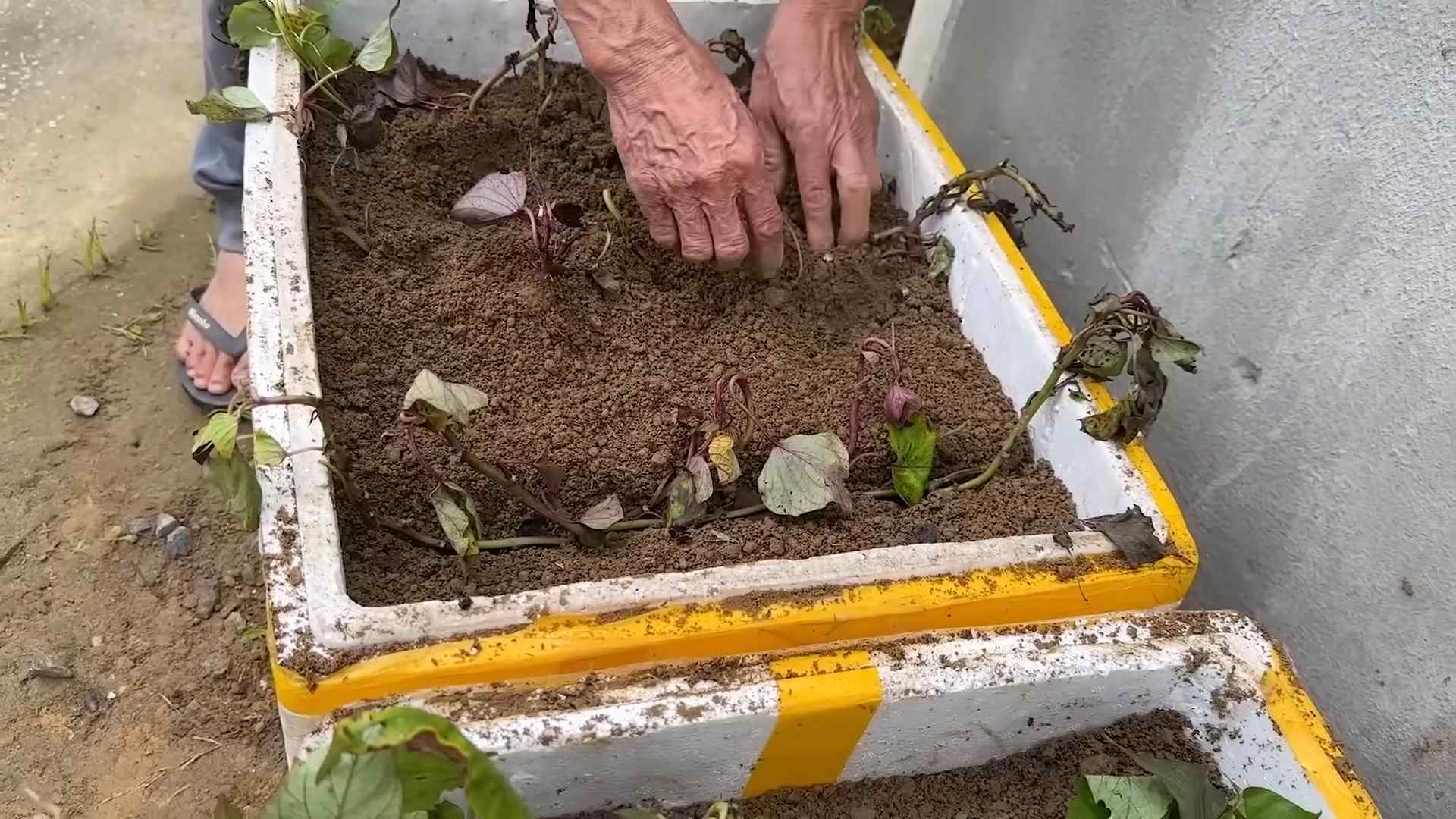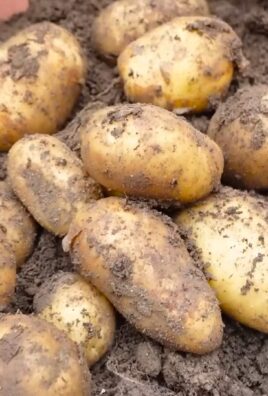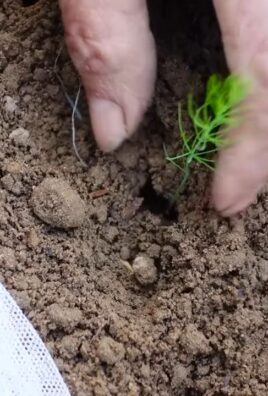Grow Sweet Potatoes at Home – imagine harvesting a bounty of vibrant, earthy sweet potatoes right from your own backyard! Forget those bland, store-bought spuds; we’re diving headfirst into the wonderful world of homegrown goodness. For centuries, sweet potatoes have been a staple in diets across the globe, from their origins in Central and South America to becoming a beloved comfort food in countless cultures. Their rich history is intertwined with traditions of sustenance and celebration.
But why should you bother growing your own? Well, for starters, the taste is simply unparalleled. Freshly harvested sweet potatoes boast a sweetness and depth of flavor that you just can’t find in the supermarket. Plus, you get the satisfaction of knowing exactly where your food comes from and that it’s free from harmful pesticides. In this article, I’m going to share some simple, yet effective, DIY tricks and hacks that will empower you to grow sweet potatoes at home, even if you have limited space or gardening experience.
We’ll cover everything from choosing the right varieties to creating the perfect growing conditions, ensuring you’ll be enjoying a delicious and nutritious harvest in no time. So, grab your gardening gloves, and let’s get started on this exciting journey to cultivate your own sweet potato paradise!

Grow Your Own Sweet Potatoes: A Beginner’s Guide
Hey there, fellow gardening enthusiasts! I’m so excited to share my experience with growing sweet potatoes at home. It’s surprisingly easy and incredibly rewarding. Imagine harvesting your own delicious, homegrown sweet potatoes – perfect for roasting, baking, or making sweet potato fries! This guide will walk you through every step, from sprouting slips to harvesting your bounty.
Choosing Your Sweet Potato Variety
Before we dive in, let’s talk varieties. Sweet potatoes come in a rainbow of colors and flavors. Some popular choices include:
* Beauregard: A classic orange-fleshed variety, known for its sweetness and reliability. This is a great choice for beginners.
* Jewel: Another orange-fleshed option, slightly drier than Beauregard, but with a rich flavor.
* Garnet: Deep red skin with vibrant orange flesh. It’s super sweet and moist, perfect for pies.
* Japanese Sweet Potato (Muraski): Purple skin with white flesh. It has a nutty flavor and a drier texture.
* Okinawan Sweet Potato: Purple skin and purple flesh! It’s less sweet than orange varieties and has a slightly earthy taste.
I personally love Beauregard because it’s so versatile and easy to grow. But feel free to experiment and find your favorite!
Sprouting Sweet Potato Slips
The first step in growing sweet potatoes is sprouting “slips.” Slips are the leafy shoots that grow from the sweet potato itself. You won’t be planting the actual sweet potato in the ground, but rather these little sprouts.
Here’s how to sprout your own slips:
1. Choose Your Sweet Potato: Select a healthy, organic sweet potato. Organic is important because non-organic potatoes may be treated to prevent sprouting.
2. Prepare Your Container: You have two options here: water or soil.
* Water Method: Suspend the sweet potato in a jar or glass of water, with the bottom half submerged. You can use toothpicks to hold it in place.
* Soil Method: Bury the sweet potato horizontally in a container filled with moist potting soil, leaving the top exposed.
3. Find a Warm, Sunny Spot: Place your container in a warm location with plenty of sunlight. A windowsill is ideal.
4. Maintain Moisture:
* Water Method: Change the water every few days to prevent mold growth.
* Soil Method: Keep the soil consistently moist, but not soggy.
5. Wait Patiently: It can take several weeks for slips to emerge. Be patient! You’ll start to see small sprouts forming on the sweet potato.
6. Harvesting the Slips: Once the slips are 6-8 inches long, they’re ready to be harvested. Gently twist or cut them off the sweet potato. I prefer twisting, as it seems to cause less damage to the potato.
7. Rooting the Slips: Place the harvested slips in a glass of water, making sure the bottom inch or two is submerged. Within a few days, roots will start to form. Change the water every other day.
8. Planting the Rooted Slips: Once the roots are about an inch long, your slips are ready to be planted in the garden!
Preparing Your Garden Bed
Sweet potatoes need plenty of sunshine and well-drained soil. Here’s how to prepare your garden bed:
1. Choose a Sunny Location: Select a spot in your garden that receives at least 6-8 hours of direct sunlight per day.
2. Prepare the Soil: Sweet potatoes prefer loose, sandy loam soil. If your soil is heavy clay, amend it with compost, sand, and other organic matter to improve drainage.
3. Create Raised Beds (Optional): Raised beds are a great way to improve drainage and warm the soil, especially in cooler climates. I highly recommend them!
4. Fertilize (Lightly): Sweet potatoes don’t need a lot of fertilizer. In fact, too much nitrogen can lead to excessive vine growth and fewer potatoes. A light application of a balanced fertilizer (like 10-10-10) before planting is sufficient.
5. Space Your Plants: Plant your sweet potato slips 12-18 inches apart in rows that are 3-4 feet apart. This gives them plenty of room to spread out.
Planting Your Sweet Potato Slips
Now for the fun part – planting your slips!
1. Water the Soil: Before planting, thoroughly water the prepared garden bed.
2. Dig Holes: Dig small holes, about 4-6 inches deep, at the spacing you determined earlier.
3. Plant the Slips: Gently remove the rooted slips from the water and place them in the holes. Bury the roots and about half of the stem.
4. Water Again: Water the newly planted slips thoroughly.
5. Mulch (Optional): Mulching around your sweet potato plants can help retain moisture, suppress weeds, and regulate soil temperature. I like to use straw or hay.
Caring for Your Sweet Potato Plants
Sweet potatoes are relatively low-maintenance plants, but here are a few things to keep in mind:
1. Watering: Water regularly, especially during dry periods. Sweet potatoes need consistent moisture, but avoid overwatering, which can lead to root rot.
2. Weeding: Keep the garden bed free of weeds, which can compete with your sweet potato plants for nutrients and water.
3. Fertilizing (If Needed): If your plants are looking pale or stunted, you can give them a light feeding of a balanced fertilizer. But remember, less is more!
4. Vine Training (Optional): Sweet potato vines can spread quite a bit. If you’re short on space, you can train them to grow along a trellis or fence.
5. Pest Control: Sweet potatoes are generally pest-resistant, but watch out for common garden pests like aphids and flea beetles. Treat infestations with insecticidal soap or neem oil.
Harvesting Your Sweet Potatoes
The moment you’ve been waiting for! Harvesting sweet potatoes is a rewarding experience.
1. Timing is Key: Sweet potatoes are typically ready to harvest about 90-120 days after planting. The leaves will start to turn yellow and the vines will begin to die back.
2. Choose a Dry Day: Harvest your sweet potatoes on a dry day to prevent rot.
3. Dig Carefully: Use a garden fork or shovel to carefully dig around the plants, being careful not to damage the potatoes. Start a foot or so away from the main stem.
4. Lift the Potatoes: Gently lift the potatoes from the soil.
5. Curing Your Sweet Potatoes: Curing is essential for developing the sweetness and flavor of your sweet potatoes.
* Clean the Potatoes: Brush off any excess soil, but don’t wash them.
* Cure in a Warm, Humid Place: Place the sweet potatoes in a warm (80-85°F), humid (85-90% humidity) location for 7-10 days. A greenhouse or a warm garage works well. You can increase humidity by placing a humidifier nearby or covering the potatoes with a damp cloth.
* Store Properly: After curing, store your sweet potatoes in a cool (55-60°F), dry place. They should keep for several months.
Troubleshooting
Even with the best planning, things can sometimes go wrong. Here are a few common problems and how to fix them:
* Slips Not Sprouting: Make sure the sweet potato is organic and that it’s in a warm, sunny location. Be patient – it can take several weeks.
* Yellowing Leaves: This could be a sign of nutrient deficiency. Try a light feeding of a balanced fertilizer.
* Root Rot: This is caused by overwatering. Make sure your soil is well-drained and avoid watering too frequently.
* Pest Infestations: Treat infestations with insecticidal soap or neem oil.
Enjoying Your Homegrown Sweet Potatoes
Congratulations! You’ve successfully grown your own sweet potatoes. Now it’s time to enjoy the fruits (or rather, roots) of your labor. Sweet potatoes are incredibly versatile and can be used in a variety of dishes. Here are a few of my favorites:
* Roasted Sweet Potatoes: Toss sweet potato cubes with olive oil, salt, pepper, and your favorite herbs, then roast at 400°F until tender and caramelized.
* Baked Sweet Potatoes: Pierce a sweet potato with a fork and bake at 400°F until soft. Top with butter, cinnamon, or your favorite toppings.
* Sweet Potato Fries: Cut sweet potatoes into fries, toss with olive oil and spices

Conclusion
So, there you have it! Growing sweet potatoes at home is not only achievable, but it’s also a deeply rewarding experience. Forget those bland, store-bought sweet potatoes – imagine sinking your teeth into a freshly harvested, vibrant orange sweet potato that you nurtured from sprout to tuber. The difference in flavor and texture is truly remarkable. This DIY project offers a unique opportunity to connect with your food source, reduce your carbon footprint, and impress your friends and family with your gardening prowess.
This method of growing sweet potatoes at home is a must-try for several reasons. First, it’s incredibly cost-effective. Starting from slips, or even just a single sweet potato from the grocery store, significantly reduces the financial burden compared to purchasing seedlings. Second, it’s adaptable to various spaces. Whether you have a sprawling backyard, a sunny balcony, or even just a few large containers, you can successfully cultivate sweet potatoes. Third, it’s a fantastic learning experience for gardeners of all levels. You’ll gain a deeper understanding of plant propagation, soil health, and the life cycle of this fascinating root vegetable.
But the benefits don’t stop there. Growing your own sweet potatoes allows you to control the growing environment, ensuring that your crop is free from harmful pesticides and herbicides. You can choose organic methods and tailor the soil composition to optimize the flavor and nutritional content of your sweet potatoes. Plus, the satisfaction of harvesting your own food is simply unparalleled.
Looking for variations? Consider experimenting with different sweet potato varieties. Beauregard is a classic choice, known for its vibrant orange flesh and sweet flavor. But don’t be afraid to try other varieties like Japanese sweet potatoes with their purple skin and creamy white flesh, or even the Covington variety, which is known for its disease resistance. You can also explore different growing mediums. While soil is the traditional choice, you can also experiment with hydroponics or aquaponics for a unique and potentially faster-growing experience. Another variation is to grow them in raised beds, which can improve drainage and soil temperature, leading to a better yield.
Furthermore, think about companion planting. Marigolds can help deter pests, while beans can fix nitrogen in the soil, benefiting your sweet potato plants. Experiment with different combinations to see what works best in your garden.
We wholeheartedly encourage you to embark on this exciting gardening adventure. Growing sweet potatoes at home is a project that will bring you joy, satisfaction, and a delicious harvest. Don’t be intimidated by the process – it’s simpler than you might think. Follow our guide, adapt it to your specific circumstances, and get ready to enjoy the fruits (or rather, the roots) of your labor.
And most importantly, we want to hear about your experiences! Share your photos, tips, and challenges in the comments section below. Let’s create a community of sweet potato enthusiasts and learn from each other. What variety did you choose? What challenges did you face? What tips did you discover? Your insights will be invaluable to other aspiring sweet potato growers. So, grab your gardening gloves, get your hands dirty, and let’s grow some amazing sweet potatoes together!
Frequently Asked Questions (FAQ)
What is the best time of year to start growing sweet potatoes?
The ideal time to start growing sweet potatoes is in the late spring or early summer, after the last frost has passed and the soil has warmed up to at least 65°F (18°C). Sweet potatoes require a long growing season, typically around 100-120 days, so starting them early ensures they have enough time to mature before the first frost of fall. If you live in a colder climate, you may need to start your slips indoors 6-8 weeks before the last expected frost.
How much sunlight do sweet potatoes need?
Sweet potatoes thrive in full sunlight, requiring at least 6-8 hours of direct sunlight per day. Insufficient sunlight can result in leggy growth, reduced tuber production, and smaller sweet potatoes. Choose a location in your garden that receives ample sunlight throughout the day. If you’re growing them in containers, make sure to place them in a sunny spot.
What kind of soil is best for growing sweet potatoes?
Sweet potatoes prefer well-drained, sandy loam soil that is rich in organic matter. Heavy clay soil can hinder tuber development and lead to misshapen sweet potatoes. Amend your soil with compost, aged manure, or other organic materials to improve drainage and fertility. A slightly acidic soil pH of 6.0 to 6.5 is ideal. Avoid soils that are excessively high in nitrogen, as this can promote leafy growth at the expense of tuber development.
How often should I water my sweet potato plants?
Sweet potatoes need consistent moisture, especially during the initial stages of growth and tuber development. Water deeply and regularly, especially during dry periods. Aim to keep the soil consistently moist but not waterlogged. Overwatering can lead to root rot and other fungal diseases. As the plants mature and the tubers begin to form, you can reduce watering slightly.
How do I know when my sweet potatoes are ready to harvest?
Sweet potatoes are typically ready to harvest in the fall, before the first frost. The foliage will begin to yellow and die back, indicating that the tubers are mature. You can also gently dig around the base of a plant to check the size of the sweet potatoes. They should be at least a few inches in diameter. Harvest on a dry day to prevent rot.
How do I cure sweet potatoes after harvesting?
Curing sweet potatoes is essential for improving their flavor, sweetness, and storage life. After harvesting, gently brush off any excess soil and allow the sweet potatoes to dry in a warm, humid place (80-85°F or 27-29°C with 85-90% humidity) for 7-10 days. This process allows the skins to harden and heal any minor cuts or bruises, preventing rot. After curing, store the sweet potatoes in a cool, dry, and well-ventilated place (55-60°F or 13-16°C) for several months.
Can I grow sweet potatoes in containers?
Yes, sweet potatoes can be successfully grown in containers, making them a great option for gardeners with limited space. Choose a large container that is at least 12-18 inches deep and wide to allow ample room for tuber development. Use a well-draining potting mix and provide adequate sunlight and water. Container-grown sweet potatoes may require more frequent watering and fertilization than those grown in the ground.
What are common pests and diseases that affect sweet potatoes?
Common pests that can affect sweet potatoes include sweet potato weevils, flea beetles, and aphids. Diseases include stem rot, black rot, and scurf. Practice crop rotation, use disease-resistant varieties, and monitor your plants regularly for signs of pests or diseases. Organic pest control methods, such as neem oil or insecticidal soap, can be used to manage infestations. Ensure good air circulation to prevent fungal diseases.
Can I eat the leaves of sweet potato plants?
Yes, the leaves of sweet potato plants are edible and nutritious. They can be eaten raw in salads or cooked like spinach or other leafy greens. Choose young, tender leaves for the best flavor and texture. Sweet potato leaves are a good source of vitamins A and C, as well as fiber and antioxidants.
How do I store sweet potatoes long-term?
Proper storage is crucial for extending the shelf life of your sweet potatoes. After curing, store them in a cool, dry, and well-ventilated place (55-60°F or 13-16°C) with moderate humidity. Avoid storing them in the refrigerator, as this can cause them to develop a hard core and lose flavor. Store them in a single layer in a basket or cardboard box, and check them periodically for signs of rot. Properly stored sweet potatoes can last for several months.




Leave a Comment